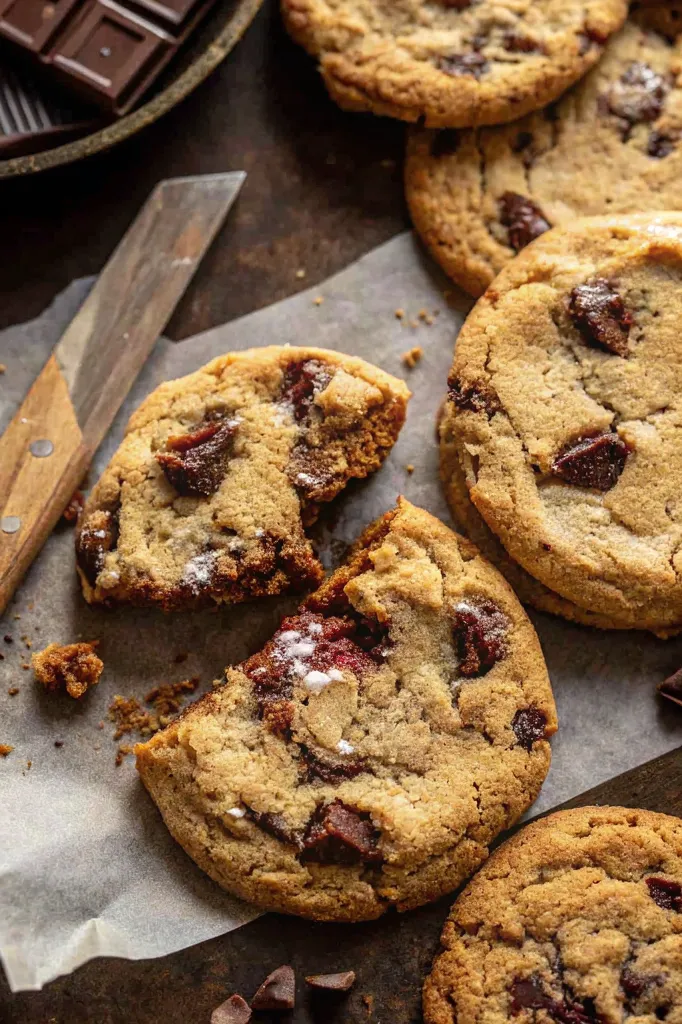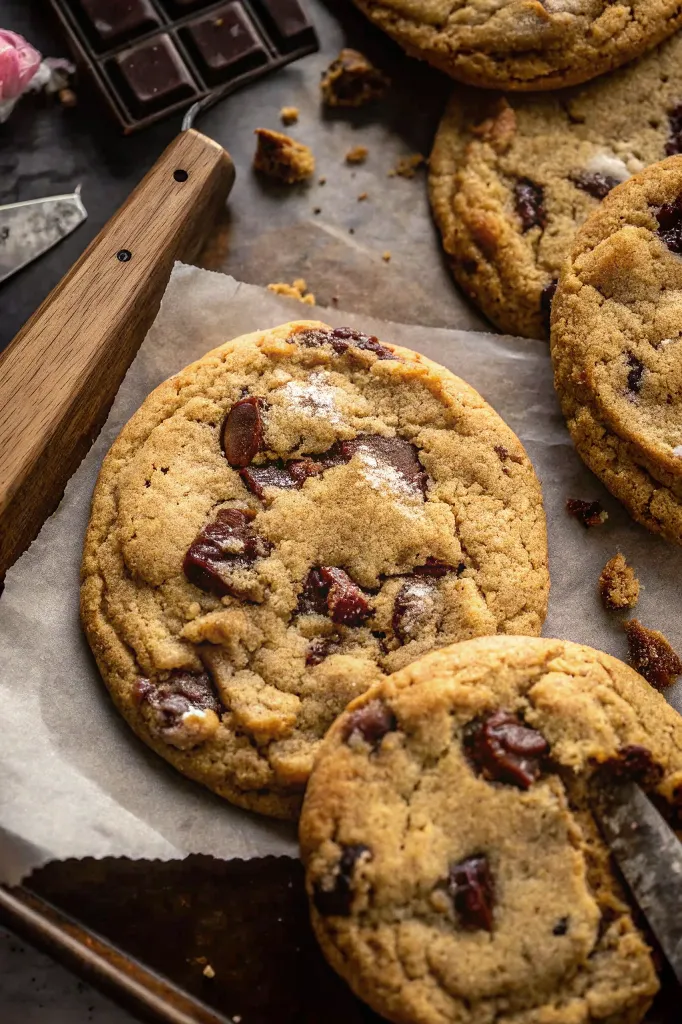If you’ve ever wondered, “Can I use protein powder instead of flour for cookies?” then welcome to the membership! Honestly, I’ve been down that road, scratching my head in the kitchen, thinking about how to make my cookies more healthy without sacrificing all the gooey goodness we crave. So, allow’s dive in, talk approximately how this switch works, what to expect, and the way you could nail it without finishing up with, nicely, protein bricks as opposed to cookies.

Why Use Protein Powder in Cookies?
First off, let’s get something straight: protein powder is not flour. It’s a different beast altogether, but it can totally work if you know what you’re doing. People swap out flour for protein powder for a few reasons:
- Adding More Protein: If you’re all about that post-gym snack life or just want a healthier treat, protein cookies are a great way to sneak in extra protein.
- Low-Carb Baking: For folks on keto or watching carbs, protein powder can be a lifesaver.
- Dietary Needs: If you’re gluten-free or just looking for alternatives, some protein powders are a perfect match.
But right here’s the deal: using protein powder as opposed to flour isn’t as simple as a 1:1 swap. Flour presents structure, while protein powder is more about, properly, protein. Too plenty, and your cookies might emerge as dry, crumbly, or downright chalky. So, let’s talk technique.
How to Substitute Protein Powder for Flour in Cookies
Ready to start baking? Here’s the lowdown on how to make this work:
1. Don’t Replace All the Flour
Here’s the golden rule: don’t pass overboard. Start by way of replacing just 25-50% of the flour with protein powder. For instance, in case your recipe calls for 1 cup of flour, use ½ cup flour and ½ cup protein powder. This keeps the shape intact whilst adding that protein increase.
2. Choose the Right Protein Powder
Not all protein powders are created equal. Here are your options:
- Whey Protein: Great for texture, but it can make cookies soft and slightly chewy.
- Plant-Based Protein: Works for vegan options but tends to make things denser, so use sparingly.
- Collagen Protein: A solid choice for cookies since it mixes well and doesn’t overpower the flavor.
Avoid powders with strong flavors unless they match your cookie flavor (like chocolate protein powder in chocolate chip cookies).
3. Adjust Your Liquids
Protein powder absorbs more liquid than flour. To avoid dry cookies, add extra moisture to the recipe. A splash of milk, a tablespoon of yogurt, or even an extra egg can make a world of difference.
4. Sweeten It Up
Some protein powders come sweetened, whilst others don’t. If your cookies aren’t tasting quite proper, you might need to alter the sugar or sweetener to stability matters out.

Can I use protein powder instead of flour for cookies? the Recipe
Want a more detailed guide with tips and variations? Check out our full guide on Protein Cookie Recipe.
Ingredients
- flour
- protein powder (whey or plant-based works best)
- butter or coconut oil, softened
- sugar or a low-calorie sweetener like erythritol
- egg
- vanilla extract
- baking soda
- A pinch of salt
- Optional: ½ cup chocolate chips or nuts
Instructions
- Preheat your oven to 350°F and line a baking sheet with parchment paper.
- In a bowl, cream together the butter and sugar until fluffy. Mix in the egg and vanilla.
- In a separate bowl, whisk together the flour, protein powder, baking soda, and salt.
- Gradually add the dry ingredients to the wet mixture. Stir in the chocolate chips or nuts.
- Scoop the dough into small balls and place them on the baking sheet. Flatten slightly.
- Bake for 8-10 minutes or until the edges are golden.
- Let them cool (if you can wait that long) and enjoy!

Tips for Better Protein Cookies
- Don’t Overmix: Protein powder can make the dough tougher, so mix just until everything’s combined.
- Experiment with Mix-Ins: Add nuts, dried fruit, or even shredded coconut for extra texture and flavor.
- Test Your Batch: Bake one cookie first to check the texture and flavor. Adjust as needed before baking the whole batch.
What to Expect When Baking with Protein Powder
Here’s the truth: cookies made with protein powder won’t be exactly like traditional cookies. They might be slightly denser, softer, or less chewy. But if you balance the ingredients and nail the technique, you’ll end up with a delicious treat that’s healthier and just as satisfying.
How Does Protein Powder Affect Cookie Texture?
When you bake with protein powder, you’re basically adding a distinct form of shape to your cookies. Protein powder tends to soak up more liquid than everyday flour, that could leave your cookies a piece at the drier aspect if you don’t compensate. That’s why it’s notable important to feature extra moisture—assume milk, yogurt, or even a little bit of mashed banana for a herbal boost.
Also, the texture will depend on the type of protein powder you’re using. Whey protein often makes cookies soft and chewy, while plant-based protein can make them firmer and more crumbly. Keep this in mind when experimenting with your favorite recipes!
Can You Make Protein Cookies Without Any Flour at All?
Here’s a fun fact: you can make cookies with no flour at all by using just protein powder, but the texture will be very different from traditional cookies. Flour acts as a binder and provides structure, so without it, you might end up with cookies that are more like dense bars. To make flourless protein cookies work, you’ll need to rely on ingredients like eggs, nut butters, or oats to hold everything together.
If you’re up for experimenting, try mixing protein powder with almond butter, an egg, and a bit of sweetener for a simple flourless cookie recipe. Just don’t expect them to taste exactly like your grandma’s cookies—they’ll have a unique vibe, but still totally tasty!
Are Protein Powder Cookies Healthy?
This is the million-dollar question. Protein powder cookies can be healthy, depending on what you add to the mix. Swapping out some flour for protein powder lowers the carb content and boosts the protein, which is great for fitness enthusiasts or anyone looking for a more balanced snack.
That said, the other elements for your recipe nonetheless remember. If you’re loading your cookies with sugar, chocolate chips, and butter, they won’t be the healthiest option. But with a few tweaks—like using herbal sweeteners, more healthy fats, and blend-ins like nuts or seeds—you can create a cookie that’s both scrumptious and proper for you.
The Best Mix-Ins for Protein Cookies
Speaking of mix-ins, let’s talk about how to make your protein cookies even better. Some of the best add-ins for these cookies include:
- Dark Chocolate Chips: Adds richness while keeping it (somewhat) healthy.
- Chopped Nuts: Almonds, walnuts, or pecans give a nice crunch.
- Dried Fruit: Think cranberries, raisins, or even chopped dates for natural sweetness.
- Coconut Flakes: Unsweetened coconut can add texture and flavor.
- Seeds: Chia seeds or flaxseeds are great for an extra nutritional punch.
These mix-ins not only add flavor and texture but can also help balance out the protein powder’s unique taste.
Does Protein Powder Affect the Baking Process?
Here’s a little science lesson for you: protein powders don’t behave like flour when heated. Unlike flour, protein powder doesn’t have gluten, which is what gives traditional cookies their structure and elasticity. When you heat protein powder, it can dry out or harden if the recipe isn’t balanced properly.
This is why protein powder cookies often bake faster than regular ones. Keep a close eye on your cookies in the oven, and don’t overbake them. Even an extra minute or two can turn soft cookies into hockey pucks. Pro tip: slightly underbaking protein cookies often results in a better texture.
What’s the Best Sweetener to Use in Protein Cookies?
Sweeteners can make or break your cookies, especially when you’re working with protein powder. Since some protein powders have a slightly bitter or chalky aftertaste, pairing them with the right sweetener is key.
Natural sweeteners like honey, maple syrup, or coconut sugar work really well in protein cookie recipes. They add moisture and flavor while keeping things healthier than refined sugar. If you’re going for a low-calorie option, try stevia, monk fruit, or erythritol. Just remember to adjust the amounts—some sweeteners are way sweeter than sugar, so a little goes a long way!
Protein Cookies for Special Diets
Another cool thing about swapping flour for protein powder is how adaptable it makes your cookies for different diets.
- Keto-Friendly: Use almond flour and whey protein for low-carb cookies. Add sugar-free chocolate chips, and you’ve got a keto treat!
- Gluten-Free: Choose a gluten-free protein powder and mix it with gluten-free oats or almond flour for a completely gluten-free cookie.
- Vegan: Use plant-based protein powder, a flax egg (1 tablespoon flaxseed meal + 2.5 tablespoons water), and coconut oil instead of butter.
Whatever your dietary needs, you can easily tweak the recipe to fit. Just remember that experimenting is part of the process—it might take a couple of tries to get the texture just right.
Final Thoughts: Is Protein Powder a Good Substitute for Flour?
While protein powder isn’t a perfect substitute for flour, it’s definitely a great way to add a nutritional boost to your cookies. By understanding how to balance the ingredients and make the right adjustments, you can create protein-packed cookies that taste amazing.
Remember, baking is all approximately trial and error. Even in case your first batch doesn’t pop out image-ideal, you’re nonetheless one step closer to studying the artwork of protein cookies. So clutch your blending bowl, your preferred protein powder, and start experimenting!
FAQs About Using Protein Powder in Cookies
Can I Use Protein Powder Instead of Flour in Cookies?
Yes, but only as a partial substitute. Replace 25-50% of the flour with protein powder to maintain structure and texture. Using 100% protein powder can make cookies dry or crumbly, so always balance it with other ingredients like eggs or liquids.
How Does Protein Powder Affect Baking?
Protein powder absorbs more liquid than flour, so recipes often need extra moisture. It also affects texture, making cookies softer or denser, depending on the type of powder used. Flavored protein powders can enhance or overpower the taste, so choose one that fits the recipe.
How Much Protein Powder Replaces Flour?
Replace up to 25-50% of the flour. For example, in a recipe needing 1 cup of flour, use ½ cup flour and ½ cup protein powder. Avoid full replacement unless following a flourless recipe.
How Do I Substitute Protein Powder in Baking?
Start small—replace 25% of the flour first. Use whey for a softer texture or plant-based protein for a denser result. Add extra liquid (e.g., milk or an extra egg) to avoid dryness, and adjust sweetness to balance any bitterness from the powder.
The Verdict: Can You Use Protein Powder Instead of Flour?
So, can you do it? Yes, however with a bit care. Swapping out a number of the flour for protein powder is definitely plausible and can bring about cookies which might be both tasty and packed with protein. Just bear in mind to experiment, adjust the beverages, and don’t be afraid to tweak the recipe to fit your taste.
And hey, even in case your first batch isn’t ideal, at the least you’re experimenting within the kitchen—and that’s half of the a laugh, right? So seize your protein powder, preheat that oven, and permit’s get baking!

1 thought on “Can I Use Protein Powder Instead of Flour for Cookies?”